Choosing the Best Foil Board for Kiteboarding Beginners
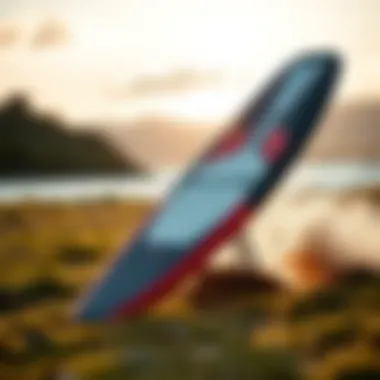
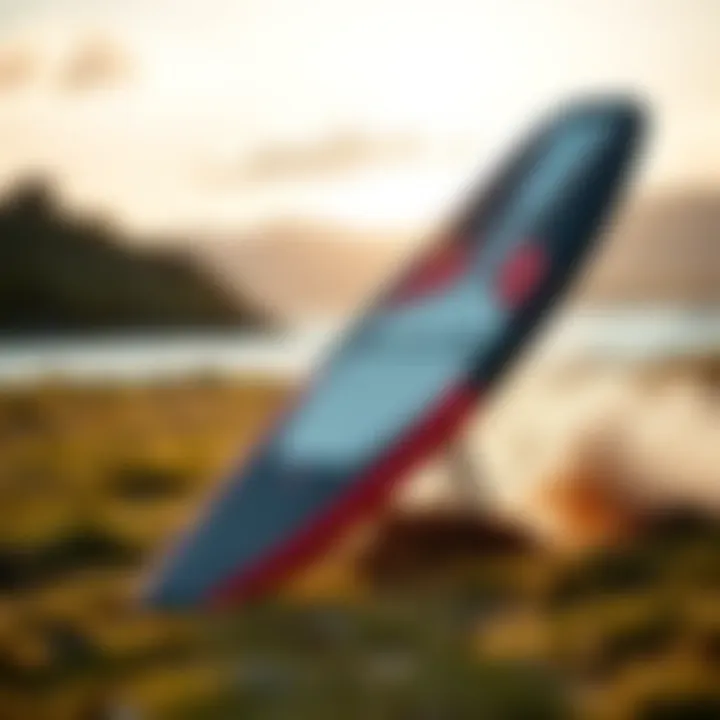
Intro
Kiteboarding opens up a world of exhilaration and freedom. Among the different forms of this sport, foil boarding stands out due to its unique mechanics and ability to glide smoothly over the water. For newcomers, selecting the right foil board can be a daunting process. The options are plentiful, each with its benefits, and it’s essential to understand the components that contribute to a satisfying ride. This guide aims to illuminate the most important factors when choosing a beginner’s foil board, helping you make an informed decision that will set the tone for your kiteboarding journey.
Equipment Insights
Choosing the right equipment can feel like searching for a needle in a haystack at times, especially for those just starting. Consequently, understanding the core features and characteristics of foil boards is key to making a selection that suits your needs.
Latest Gear Reviews
When diving into the market for a foil board, look for reviews from reputable sources to get the lowdown on the latest gear. For beginners, stability and ease of use are crucial. Brands like Naish, Slingshot, and Cabrinha have recently released boards tailored for those learning the ropes. Here are some noteworthy models:
- Naish S25 Hover 130: Known for its buoyancy, this board allows new riders to progress rapidly. It’s light, flexible, and has ample surface area, making it perfect for taking off smoothly.
- Slingshot Flyer 120: A shorter option offering great maneuverability while still providing a stable ride. It’s ideal for those finding their groove on the water.
- Cabrinha XCaliber 135: Great for the budget-conscious beginner, it balances performance and affordability, delivering a satisfying learning experience.
Using these boards can significantly impact how quickly you'll adapt to foil kiteboarding, so consider your size and weight in relation to the board's specifications.
Essential Gear Maintenance
Proper maintenance can extend the lifespan of your foil board and improve your experience overall. Here are some tips to help keep your board in top shape:
- Rinse with Fresh Water: Always rinse the board and foil parts with fresh water after use. Salt and sand can cause corrosion and other long-term damage.
- Inspect for Damages: Regularly check for dings or cracks, especially near the edges. Minor issues can lead to bigger problems, affecting performance.
- Wax the Bottom: Maintaining the bottom surface helps with glide and performance. A light layer of wax ensures smoother rides and can assist in increasing speed.
"Selecting the right foil board lays the groundwork for a successful learning phase in kiteboarding. It’s not just about the size but how it complements your kite experience."
Technique Exploration
Once you've secured a suitable foil board, the next step is diving into the techniques that will enhance your skills. It’s imperative to understand how to control the board effectively to enjoy kiteboarding fully.
Beginner Techniques
For novices, mastering the basics is essential. Start with practicing in calm waters. Here are some fundamental techniques to focus on:
- Balance Drills: Practice standing up on the board in shallow water before launching into the full kiteboarding experience.
- Controlled Launches: Work on launching your kite while maintaining control over the board.
- Kite Control: Learn to maneuver the kite smoothly to create lift and steer.
Advanced Maneuvers
Once you feel comfortable on the board, you can begin exploring more advanced maneuvers. Building up your confidence gradually is key. Focus on:
- Carving Turns: Techniques to change direction smoothly while maintaining speed.
- Jumping: Learn to harness the power of the kite for small jumps, adding fun elements to your riding.
- Transitions: Move seamlessly from heel to toe-side riding, which is particularly important for executing tricks.
Understanding Foil Boards
Understanding foil boards is crucial for anyone venturing into the world of kiteboarding. These boards come with an engineering marvel beneath them, allowing riders to glide over water, creating a sense of freedom and weightlessness. For beginners, grasping the essentials of a foil board is the stepping stone to enjoying the sport without frustrations stemming from improper equipment.
What is a Foil Board?
A foil board is a type of surfboard equipped with a hydrofoil, which is a submerged wing-like structure. This foil lifts the board above the water surface as it gains speed, drastically reducing water resistance. You can think of it like an ice-skater gliding effortlessly across the rink. As the board rises, it provides an exhilarating ride with minimal drag, making it easier to catch wind and maneuver through waves.
Besides just being a board, it’s an intricate piece of technology designed for performance. For the beginner, understanding this dynamic can reshape your approach to learning kiteboarding. One might consider the foil board as a bridge to exploring the exhilarating aspects of the ocean, as it fundamentally alters how you interact with the water.
Components of a Foil Board
A typical foil board comprises three critical components: the board itself, the mast, and the foil (or wing). Each piece plays a role in the overall performance and understanding their functions can significantly impact your initial decisions.
- Board: The main platform on which you stand. It varies in size and shape, influencing stability and maneuverability.
- Mast: This connects the board to the foil. Heights may vary, affecting how high the board rides above the water.
- Foil/Wing: Usually made of aluminum or carbon fiber, the wings are designed to create lift as water flows across them. The shape and size of these wings play a crucial role in how the board behaves.
Gearing up begins with recognizing whether the components fit your skill level and learning curve.
How Foil Boards Function
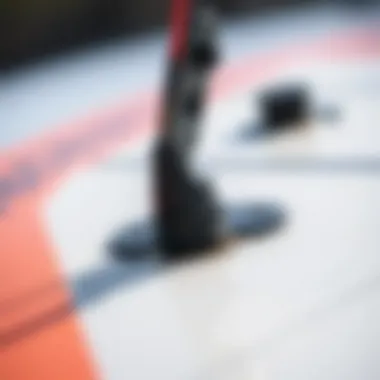
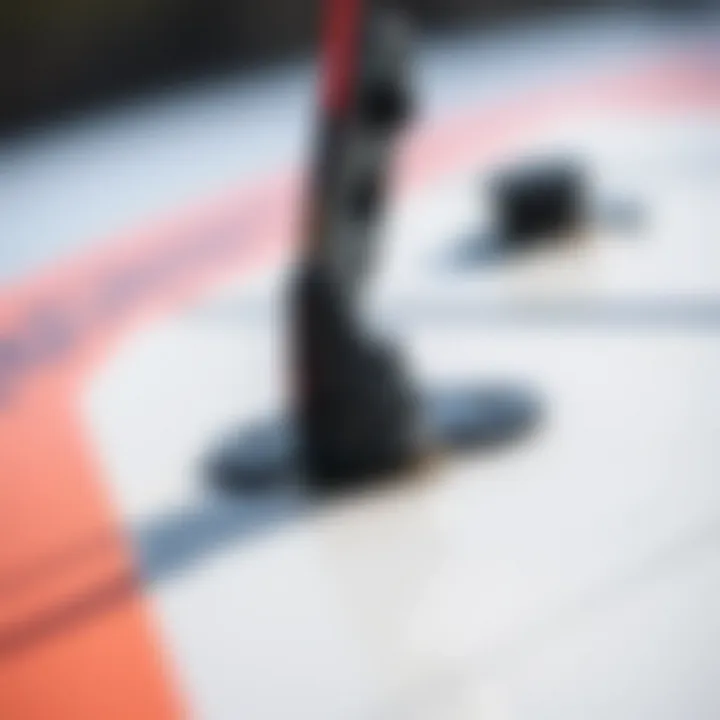
Foil boards operate through the principles of hydrodynamics. As the board moves forward and water flows over the wings, a pressure difference is created, resulting in lift. The user must achieve a certain speed to generate enough force for the foil to rise. It’s akin to taking off in a plane; without enough speed, it just won’t happen.
Many novices might find that starting with a larger wing encourages lift at lower speeds. However, as one becomes more comfortable with the mechanics, experimenting with different wing sizes can yield improved agility and speed. It enhances overall skillsets while diving into deeper aspects of kiteboarding.
In summary, comprehending how foil boards function is integral for beginners. Knowing how the board interacts with water and wind can give riders the confidence needed to navigate their first sessions effectively. As one’s knowledge of the gear deepens, so does the ability to harness the elements, ultimately leading to a more enjoyable experience on the water.
Importance of Choosing the Right Foil Board
Selecting the right foil board as a beginner is more than just a matter of preference; it can significantly shape your experience in kiteboarding. The decisions you make now will ripple through your learning journey, affecting how quickly you progress, how stable you stay on the water, and how much fun you have. Consider this your foundational step into a sport that values finesse and skill.
When faced with the vast array of options available today, understanding the specific benefits and considerations surrounding foil boards can mean the difference between a smooth ride and a frustrating struggle.
Impact on Learning Curve
The learning curve in kiteboarding can be steep, especially for newcomers. Choosing an appropriate foil board can either smooth out that curve or make it exceptionally rugged. A board that is designed for beginners typically offers increased stability and easier maneuverability. For example, a larger volume board can keep you afloat with less effort, allowing you to focus on mastering essential techniques rather than worrying if you’ll sink.
To put it plainly, if you’ve got a board that keeps you more grounded (figuratively speaking), you’re more likely to make the progress you want without feeling like you’re constantly treading water.
Key Points on Learning Curve Benefits:
- Easier Balance: A stable board helps maintain balance, which is crucial during early attempts.
- Less Frustration: Increased ease of use means you can focus on what you enjoy—riding—rather than battling equipment.
- Quicker Mastery: With less energy spent on stability, you can spend that time refining your technique.
Performance and Stability
Going hand-in-hand with the learning curve is the board’s performance under different conditions. New riders must understand that the right equipment can offer a level of stability that bolsters their confidence in various wind and water conditions. A foil board designed for beginners tends to feature wider wings and a suitable deck shape, lending itself to easier flight and better control.
Imagine gliding effortlessly above the water, where a board tuned for novices allows you to focus on communication between your body and the kite. If your board feels unresponsive or wobbly, not only does that hamper performance, but it can also sap your enthusiasm.
Important Features for Performance:
- Wider Wings for Lift: Helps in maintaining altitude and controlling descents more effectively.
- Stable Shape Design: A board that doesn’t feel like a teeter-totter elevates your confidence when riding.
- Responsive Materials: Some boards allow for a connection with the water that enhances performance.
Safety Considerations
Safety cannot be emphasized enough in kiteboarding—especially for beginners. An ill-chosen foil board can present dangers not just to the rider but also to others on the water. Increasing stability and ensuring proper sizing can prevent problematic falls. A board designed for novice use contributes to overall safety by reducing the likelihood of wipeouts and enabling safer practices.
To stay safe, pay attention to the design specifics of the board. Look for features that can mitigate the risks associated with kite surfing, such as rounded edges that lessen the risk of injury from sharp surfaces.
Safety Tips:
- Proper Sizes: Use a board of appropriate size to reduce risks; larger boards can often provide more stability.
- Rider Awareness: Awareness of your surroundings is key. Staying mindful while learning to control both the foil and kite protects you and others.
- Practice at Safe Locations: Choose less crowded areas to minimize collision risks until you feel more confident on the board.
In summary, taking the time to understand the importance of choosing the right foil board is an investment in your kiteboarding journey. Your selection will not only dictate your learning curve, but also your performance, stability, and safety on the water. Take this initial step seriously, and it will pay dividends down the road.
"The right board can be the breeze in your sail; it gives you confidence to explore the waves without hesitation."
For more information on safety practices and equipment, you may want to visit the following resources:
- Kiteboarding safety guidelines
- Foilboarding tips from experienced riders
- Kiteboarding Safety Education
By keeping these factors in mind, you'll be heading in the right direction toward enhancing your kiteboarding experience.
Key Features to Look For in a Beginner Foil Board
Choosing a foil board is a pivotal step for those just dipping their toes into kiteboarding. Selecting the right board can mean the difference between levitating gracefully over the water or toppling unceremoniously into it. As beginners, understanding the unique features that cater to novice riders greatly enhances the learning experience. Here, we delve into essential characteristics that every beginner foil board should ideally possess.
Volume and Length
When it comes to a beginner foil board, volume and length play a starring role. These attributes influence buoyancy and stability, crucial factors for those still mastering kite control and riding techniques. A board with a larger volume offers more buoyancy, which is particularly beneficial for riders who may not yet possess the skill to maintain balance effortlessly. If you happen to take a spill, a thicker board can help you regain control more easily.
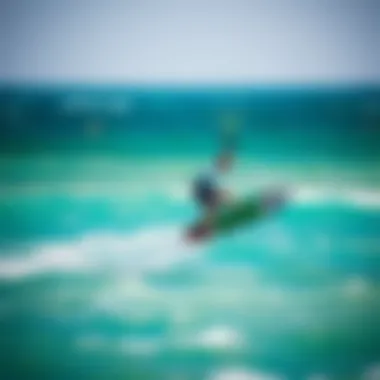
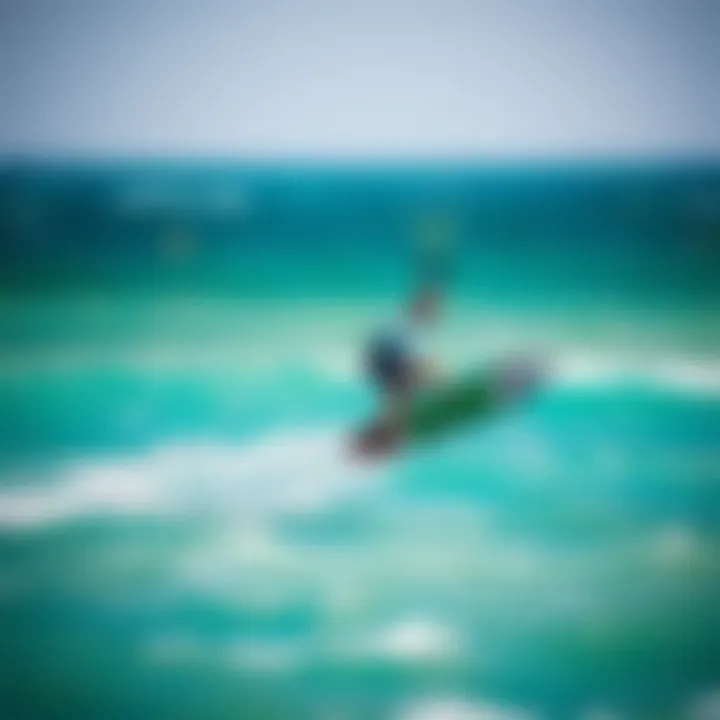
The length of the foil board also matters. Generally, longer boards offer greater stability and a smoother ride, making them favorable for new learners. A board in the range of 5 to 6 feet can provide that perfect blend of ease and performance, allowing beginners to appreciate both the thrill and tranquility of foil riding. However, it’s wise to avoid boards that are excessively long, which can hinder maneuverability. To sum it up, a well-sized board gives a beginner a fighting chance at mastering those initial challenges on the water.
Weight Distribution
A well-designed board is not just about the materials but also how weight is distributed throughout. For a novice rhinoceros, weight distribution affects how well the board floats, turns, and even how it feels during takeoff and landing. Boards specifically crafted for beginners often feature a lower weight distribution towards the tail, which aids in lift-off and provides that much-needed stability when flying above the waves.
Balancing the weight effectively allows riders to experience smoother transitions from water to air. If the board’s weight is concentrated at the front, it can lead to nose diving, which is anxiety-inducing to say the least. Thus, look for boards with a balanced feel underfoot - you’ll thank yourself during those first few rides.
Material Considerations
The choice of materials for a foil board can significantly impact performance and longevity. Boards are generally constructed from epoxies, carbon fiber, or foam composites. For beginners, epoxy boards are often more forgiving; they are durable, relatively lightweight, and able to withstand the inevitable bumps and drops during the learning stage.
On the other side of the spectrum, carbon fiber boards bring in a super lightweight design but can come with a higher price tag. For newbies, choosing an economical board made from good-quality foam and epoxy will serve well until skills progress and the desire for advanced performance kicks in.
In addition to material, considering how the board has been constructed is crucial. Look for reinforced edges to protect against dings and damage. Remember, it’s a learning journey, and minor mishaps are bound to happen. It’s often sensible to invest in a board that can survive a few rough rides without losing its charm.
As you embark on your kiteboarding adventure, keep these features in mind. Selecting a board aligned with your current abilities will enhance both safety and enjoyment on the water.
Whether you’re perusing local shops or window shopping online, understanding volume, weight distribution, and materials will guide you in making an informed choice. This foundational knowledge paves the way for a successful and exhilarating kiteboarding experience.
Top Foil Boards for Beginners
When delving into kiteboarding, especially for those new to the sport, selecting the right foil board can mean the difference between a thrilling adventure and a frustrating experience. The significance of this choice cannot be overstated; it serves as the foundation for learning the intricacies of foil riding. A well-chosen board enhances buoyancy, stability, and maneuverability, directly impacting how swiftly a novice rider can get up and gliding.
So why focus on beginner-friendly models? Simply put, these boards are designed with thoughtful attributes that cater to the needs of learners. Features like increased surface area, forgiving flex patterns, and lightweight materials ensure that newcomers experience less resistance and more enjoyment. Understanding what makes a model suitable for beginners requires examining specific criteria tailored to the complications that come with learning this exhilarating sport.
Beginner-Friendly Models Overview
When shopping for a foil board, you might wonder which options fall into the beginner category. It’s essential to keep in mind that not all foil boards are created equal; some cater better to novices than others.
Some notable beginner-friendly models include:
- Naish Boxer Foil Board: This board aids in stability thanks to its wider outline and forgiving flex. In addition, it encourages a buoyant ride, allowing beginners to find their balance more easily.
- Slingshot Hover Glide: Known for its light weight and robust construction, this board helps riders feel connected to their movements. It provides a smooth entry into the realm of foiling without being overly intimidating.
- Fanatic Sky Assy Foil: Its user-centric design allows for easy takeoffs and steady rides, making it a favorite among new riders.
Each of these choices comes with its own set of advantages and learning curve facilitations, making them viable entry points into the world of kiteboarding.
Detailed Reviews of Recommended Brands
Understanding the intricacies of specific brands can guide choice further. Here’s a closer look at some standout options:
- Naish
- Slingshot
- Fanatic
- Strengths: The Naish Boxer is well-regarded for its durability and ease of use. Made with high-quality materials, it provides a reliable sense of safety in choppy waters.
- Best for: Riders looking for a mixture of performance and stability in diverse conditions.
- Strengths: The Hover Glide offers versatility and performance. Its design incorporates a larger surface area that makes learning to foil less daunting.
- Best for: Riders keen on engaging in various board sports while still being adept at foiling.
- Strengths: With a design focused on user experience, the Sky Assy offers a smooth ride that is forgiving during missteps.
- Best for: Newcomers anxious about balance and stability, providing peace of mind during their first forays into kiteboarding.
Price Range and Value Assessment
The cost of a foil board can vary significantly, with beginner models sitting comfortably in the mid-range spectrum. Prices typically range from about $800 to $1,500, depending on brand reputation, materials, and design specifics.
Some points to bear in mind when assessing value include:
- Quality over Cost: A higher price doesn't always equate to a better board. It's vital to evaluate based on features that cater specifically to beginners.
- Long-Term Investment: Choosing a model that may be slightly pricier but is built to last can ultimately save money in the long run as it avoids earlier replacements as riders advance.
- Opportunities for Resale: Certain brands hold their value well, offering potential resale opportunities as one’s skills develop and the need for a more advanced board arises.
Overall, investing time in research and comparisons can bridge the gap between selection and satisfaction in the kiteboarding journey.
Safety Practices for New Riders
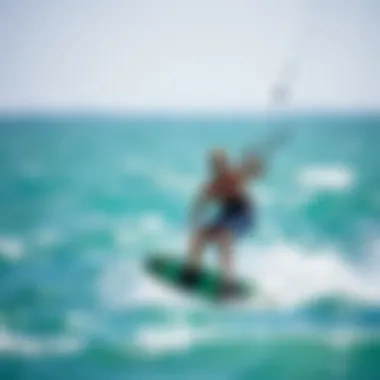
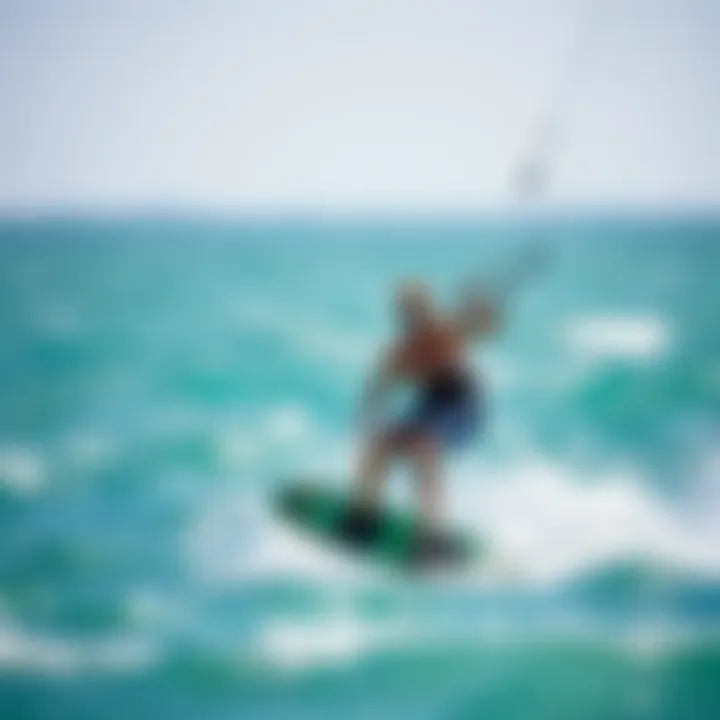
Safety practices are paramount for anyone venturing into kiteboarding, especially for newcomers. The thrill of riding the waves can be exhilarating, but without proper precautions, it can also be dangerous. Knowing how to safeguard oneself not only enhances the experience but can also significantly mitigate risk. This section aims to highlight crucial safety practices that novice riders should embrace right away.
Understanding Risks Involved
Kiteboarding, with its unique blend of wind and water, comes with a set of risks that every new rider needs to understand. Falling is a common occurrence, and for beginners, it might happen more frequently than expected. Whether due to misjudged wind speed or a momentary lapse in concentration, knowing how to handle falls is vital. It’s not merely about the act of falling, but also the awareness of surrounding hazards like other riders, hard objects in the water, or even strong currents.
Another important aspect is the risk of overexertion. In the enthusiasm to master the sport, one can easily push beyond personal limits, leading to injury or fatigue. Recognizing when to take a break is essential for long-term enjoyment and safety. So, always listen to your body and don’t hesitate to rest.
"Safety isn’t just a priority; it’s a habit that can protect your dreams on the water."
Essential Protective Gear
The right protective gear can make a world of difference for a beginner kiteboarder. Here’re the essentials:
- Helmet: Always wear a helmet, especially when starting out. It protects your head from impacts, whether from falls or collisions with the board.
- Impact Vest: This not only provides buoyancy but also cushions your body on impact with the water. It’s like having an extra layer of security as you learn the ropes.
- Wetsuit: Depending on the climate, a wetsuit can offer thermal protection, shield you from the sun, and help in reducing the sting of falls.
- Leash System: Get a reliable leash for your board to prevent it from floating away if you take a tumble. Losing your board can lead to potential hazards for you and other riders.
Investing in good gear early on lays the foundation for safe practices and can enhance your confidence in the water.
Waves and Wind Condition Awareness
No wind, no kiteboarding. The wind is your best friend, but it can also be tricky. For beginners, understanding wind conditions is not just about knowing which way it blows; it’s about interpreting how strong it is and predicting how it might change.
When starting, it’s advisable to always check the local weather reports and conditions. If you're in a particularly windy area or facing gusty conditions, consider waiting for calmer winds before heading out. Learning to read the water is just as crucial; observe the surface for signs of currents or the presence of waves. These can affect not just your balance but also your trajectory.
Don't just rely on forecasts. Talk to local riders and instructors; they can provide invaluable insights about the local conditions that can help you make safe decisions. Being aware and patient can really turn those rough edges of learning into smoother sailing.
While the excitement of kiteboarding is undeniable, it is essential to prioritize safety above all. Embracing these practices will not only enhance your learning experience but also pave the way for a fulfilling progression in this thrilling water sport.
Maintenance of Foil Boards
Maintaining a foil board is crucial for ensuring not just its longevity but also the safety and performance of your rides. Neglecting this aspect might lead to unexpected repairs and could compromise your experience on the water. Regular maintenance helps preserve the integrity of the board's materials, keeps it performing well, and ultimately enhances the overall kiteboarding experience. After all, a well-cared-for board can make the difference between a smooth glide above the water and a turbulent ride.
Routine Checks and Maintenance Tips
When it comes to routine checks, keeping an eye out for specific scenarios is key. Here are some essential maintenance tips:
- Inspecting the Fuselage: This connects the wings and board, making it paramount to inspect for signs of wear or any loose fittings. A quick visual check is often enough to catch anything amiss.
- Checking the Wing: The wings can sometimes incur nicks and scratches that might affect performance. If you notice anything that looks like it might weaken the structure, it’s best to address it down the line.
- Foil Board Surface: Look for cracks or chips in the board's surface. While small cosmetic issues might not impact performance, they can lead to bigger problems if they allow water intrusion.
- Screws and Fittings: Make sure that all screws and fittings are tightened properly. Loose parts can create instability while riding and lead to accidents.
Don't forget to rinse your foil board with fresh water after riding, especially if you've been out in salt water. Salt can corrode materials over time, so a simple wash can go a long way.
Storage Best Practices
Proper storage is just as important as routine checks. How you store your foil board can determine its longevity significantly. Follow these tips to keep your gear in excellent condition:
- Choose the Right Spot: Store your board in a cool, dry place away from direct sunlight. UV rays can degrade materials over time, affecting both aesthetics and function.
- Use a Board Bag: Investing in a good quality board bag is worthwhile. This not only protects your board from scratches and bumps but also makes it easier to transport.
- Avoid Excessive Weight: Ensure that your board is not subjected to excessive weight while stored, as it can cause warping or damage to delicate components.
- Regular Cleaning Before Storage: Clean your board thoroughly before storing it for any length of time. This helps prevent any dirt or salt residue from sticking and causing future issues.
Taking the time to implement these maintenance tips and storage practices may seem cumbersome, but they pay off in the long run. Well-kept gear enhances your performance and safety, providing a better kiteboarding adventure. As with anything, a bit of diligence can save you from bigger troubles down the line.
Culmination
Choosing the right foil board as a beginner in kiteboarding is not just about picking a trendy model or one that looks good. It’s a decision that can significantly shape your entire riding experience. A suitable board gives you the foundation you need to learn and develop your skills efficiently without risking your safety in the process. By thoughtfully considering the elements we've discussed, like board volume, material, and stability, you can make an informed choice that suits your individual style and comfort level.
Recap of Key Considerations
To sum up, here’s a quick checklist you might find useful:
- Volume and dimensions: Ensure the board has enough volume to provide buoyancy and stability, especially in choppy waters.
- Material type: Lightweight materials like carbon or epoxy can enhance performance, but they might cost more than typical fiberglass boards.
- Weight distribution: Pay attention to how weight is balanced along the board to maintain control when riding.
- Board size: Larger boards can give you more stability, while smaller ones can be quicker for maneuvering.
By keeping these factors in mind, beginners can find a board that not only gets them up in the air but does so with confidence and less hassle.
Encouraging Safe Practice
When addressing the importance of safety in kiteboarding, it is crucial to remember that excitement shouldn’t overshadow common sense. Make sure you are comfortable on your board before watching the horizon. Before you hit the water:
- Wear appropriate safety gear, like a helmet and impact vest. This’ll offer protection in case you take a spill or get knocked about by a gust of wind.
- Always check wind and water conditions before heading out. Not only does it affect your performance, but it also plays a significant role in your safety.
- Consider engaging with experienced riders or taking lessons to sharpen your skills and boost your confidence. They can provide invaluable tips and insights, ensuring that you're not only learning the tricks of the trade but also where the hazards might lie.
Taking safety seriously makes your experience more enjoyable. Keep these guidelines in mind as you embark on your kiteboarding journey, and you'll be more likely to foster a lifetime of enjoyment and adventure on the water.







